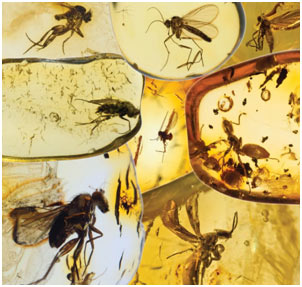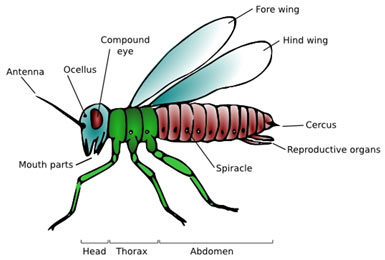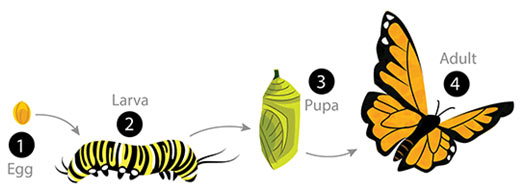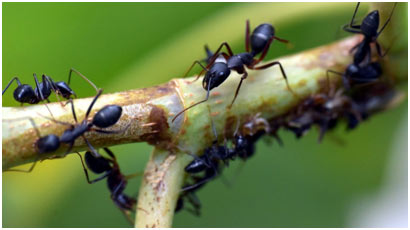Overview
The study of insects is called entomology; the word which is derived from Greek “Entoma” meaning cut into. Insects are the most diverse organisms on Earth.
Insects are the group of phylum Arthropoda.
Like all arthropods, insects also have exoskeletons made of chitin, a body divided into segments and protected with a cuticle.
They have an open blood circulatory system with organs openly bathed in a fluid called hemolymph.
Body segmentation means the division of the body externally into different regions and the process is termed as tagmosis.
The beautiful colors of insects are due to pigments in exocuticle such as melanin.
Insects
Insects come from the phylum Arthropoda. Arthropods are characterized by having the following functions: a hard external skeleton (called an exoskeleton), a segmented body, at least 3 sets of jointed legs. The Arthropoda is divided into a number of classes. These consist of the:
- Crustacea (crabs, crayfish, prawns).
- Arachnida (spiders, mites, scorpions).
- Myriapoda (millipedes & centipedes).
- Insecta (insects)
Insects are the most extensively dispersed and the most various of all animals. They can be found in the oceans, on polar ice caps and flying over the Mountain ranges and living in steaming hot volcanic springs. According to one computation, there are about 1,000, 000, 000,000,000,000,000 (one million trillion) insects in the earth, more than a billion for every single person.
Of the 2 million approximately known species of plants and animals about 700,000 of them are insects. New insects are found and named at a rate of about 2,000 a year. Thousands– possibly millions to be discovered. In regards to weight, insects account approximately 85 percent of all animal life types, All the world’s insect weighs more than 12 times all the world’s individuals.
Evolution of Insects

Insects are an ancient group of animals. The very first insects probably appeared before the Devonian duration (400 – 360 million years ago) and by the Carboniferous duration (360 – 285 million years ago) had taken to the air.
Adaptation to flight showed a highly effective method and throughout the Permian period (285 – 245 million years ago) insects attained their biggest variety. No other arthropod group has attained flight. By the Permian, the basic physical structure of many of the modern-day orders of insects had developed.
The more recently progressed Hymenoptera (ants, bees, wasps and sawflies) and Lepidoptera (butterflies and moths) appear as fossils in the Jurassic duration (210 – 145 million years ago). The Mantodea (hoping mantids) appeared in Eocene duration in fossilized amber (60 – 35 million years ago).
The Successful Group
The insects are the most effective arthropods. There are even more species in the class Insecta than in any other group of animals. These remarkably diverse animals have actually dominated all the environments on earth except for the frozen polar environments at the greatest elevations and in the instant vicinity of active volcanoes. Insects are the only invertebrates (animals without a backbone) with wings.
Much of their success results from their capability to fly and colonize new habitats. An easy escape from enemies. They can quickly disperse to new environments. Can exist in extremely little spaces and specific niches.
They Produce a large number of offspring relatively very quickly. The genetic variety and great potential for adaptation to new or changing environments are likewise essential elements which made insects the most successful group on the Earth.
General Characteristics of Insects
No matter their size, behaviour or habitat, insects worldwide have common physical attributes.

The exoskeleton
Insects have an external skeleton called an exoskeleton. This hard covering secures and supports the body. It is made up of 2 layers. The outer layer is thin, waxy and water-resistant. The inner layer is much thicker and is made from chitin. Depending on the insect, the exoskeleton can be rather hard and rigid– like that of a cockroach or less so when the insect is in its larval (caterpillar) phase or if it has a soft body– like a blue blowfly.
The exoskeleton is non-living so it can not grow with the insect when it remains in its larval form or as a grownup. Insects shed their old exoskeletons, expand to a bigger size and then wait for the new exoskeleton to solidify. This is called moulting, and it occurs sometimes throughout an insect’s life expectancy. One of the most common signs of moulting comes in the spring when we find cicada shells (exoskeletons) on trees and fences.
The head
The head is the top section of an insect’s body. A number of the insect’s sense organs are found here. A set of antennae allow insects to smell, feel the surface area of an item, sense cold and hot, listen to noises or detect motion. Insects have a set of compound eyes– each made up of countless lenses.
Compound eyes offer a larger field of vision, which is truly beneficial for flight or when searching for prey. Insects might likewise have simple eyes called ocelli, which include single lenses. They enable insects to notice light and dark. The insect’s mouthparts are likewise on the head.
Insects have actually developed mouthparts for a variety of functions. Insects such as beetles and grasshoppers have mouthparts that permit them to chew. Butterflies and moths have a proboscis that permits them draw liquids. Insects like mosquitoes have mouthparts that pierce their food, while houseflies sponge their food, dissolving it in saliva before sucking it up.
The thorax
The thorax is an insect’s middle section. It includes three sections. Each section has a set of jointed legs. If the insect has wings, a pair of forewings and a set of hind wings are attached to the thorax. Like our native birds, Aotearoa New Zealand has a significant number of wingless or flightless insects. For instance, the honi/mole cricket is the only wingless mole cricket worldwide.
The abdomen
The abdomen is the rear or last section of the insect. This is where the digestive, excretory and reproductive organs lie. The abdomen has 9– 11 segments. Each segment has a pair of spiracles or openings in the exoskeleton. Insects open the spiracles to catch air in but close them to prevent water loss. Marine insects have comparable approaches to prevent water from entering the spiracles.
Development and Growth
Insects hatch from eggs as larvae or grub that often look like brief, stubby worms. They then become a pupa and finally metamorphose into a full-grown insect. As they grow they shed their old skins exoskeletons and grow new ones. Larvae and pupa spend much of their time eating. Unlike bird eggs, insect’s eggs include really little yoke or food. Rather the eggs are laid on or near food sources and the young start consuming as quickly as they hatch. The primary purpose of insects is to reproduce.

These are the features that can help us differentiate insects from other arthropods.
MCQs
- What is the scientific study of insects called?
- a) Ornithology
- b) Entomology
- c) Herpetology
- d) Ichthyology
- Answer: b) Entomology
- Insects belong to which phylum?
- a) Mollusca
- b) Arthropoda
- c) Annelida
- d) Chordata
- Answer: b) Arthropoda
- How many known species of plants and animals are insects among them?
- a) 100,000
- b) 500,000
- c) 700,000
- d) 1 million
- Answer: c) 700,000
- What is the main reason for the success of insects as a group?
- a) Ability to swim
- b) Ability to fly
- c) Ability to camouflage
- d) Ability to burrow
- Answer: b) Ability to fly
- During which geological period did insects likely appear for the first time?
- a) Devonian
- b) Jurassic
- c) Permian
- d) Carboniferous
- Answer: a) Devonian
- Which group of insects is considered the most successful in terms of diversity?
- a) Lepidoptera
- b) Coleoptera
- c) Hymenoptera
- d) Diptera
- Answer: c) Hymenoptera
- What is the purpose of the exoskeleton in insects?
- a) Temperature regulation
- b) Protection and support
- c) Digestion
- d) Reproduction
- Answer: b) Protection and support
- What is the outer layer of the insect exoskeleton composed of?
- a) Keratin
- b) Chitin
- c) Calcium carbonate
- d) Collagen
- Answer: c) Chitin
- Which part of the insect’s body contains sense organs like antennae and compound eyes?
- a) Abdomen
- b) Thorax
- c) Head
- d) Legs
- Answer: c) Head
- What is the function of ocelli in insects?
- a) Chewing food
- b) Smelling
- c) Detecting light and dark
- d) Sucking liquids
- Answer: c) Detecting light and dark
- In which section of the insect is the thorax located?
- a) Head
- b) Abdomen
- c) Middle section
- d) Limbs
- Answer: c) Middle section
- How many pairs of jointed legs does an insect have?
- a) 2
- b) 4
- c) 6
- d) 8
- Answer: c) 6
- Which insect class includes crabs, crayfish, and prawns?
- a) Insecta
- b) Arachnida
- c) Myriapoda
- d) Crustacea
- Answer: d) Crustacea
- What is the primary purpose of insect eggs?
- a) Food storage
- b) Reproduction
- c) Protection
- d) Temperature regulation
- Answer: b) Reproduction
- During which phase do insects molt and shed their old exoskeletons?
- a) Pupa
- b) Larva
- c) Adult
- d) Egg
- Answer: b) Larva
- How do insects primarily obtain genetic diversity for adaptation?
- a) Sexual reproduction
- b) Asexual reproduction
- c) Budding
- d) Fragmentation
- Answer: a) Sexual reproduction
- What is the fluid that bathes the organs in an insect’s open circulatory system called?
- a) Blood
- b) Hemolymph
- c) Lymph
- d) Plasma
- Answer: b) Hemolymph
- What percentage of all animal life forms do insects approximately account for in terms of weight?
- a) 50%
- b) 65%
- c) 75%
- d) 85%
- Answer: d) 85%
- Which insect group appears as fossils in the Jurassic period?
- a) Coleoptera
- b) Hymenoptera
- c) Lepidoptera
- d) Mantodea
- Answer: b) Hymenoptera
- What is the primary component of an insect’s exoskeleton that prevents water loss?
- a) Outer layer
- b) Waxy coating
- c) Inner layer
- d) Spiracles
- Answer: c) Inner layer
- Which group of insects includes ants, bees, wasps, and sawflies?
- a) Coleoptera
- b) Diptera
- c) Hymenoptera
- d) Orthoptera
- Answer: c) Hymenoptera
- How many segments does the abdomen of an insect typically have?
- a) 5-7
- b) 7-9
- c) 9-11
- d) 11-13
- Answer: c) 9-11
- What process do insects undergo to transform from larvae to full-grown insects?
- a) Hibernation
- b) Metamorphosis
- c) Molting
- d) Fertilization
- Answer: b) Metamorphosis
- In which habitat can insects not be found according to the information provided?
- a) Oceans
- b) Polar ice caps
- c) Mountain ranges
- d) Volcanic springs
- Answer: b) Polar ice caps
- What is the primary factor contributing to the success of insects in colonizing new habitats?
- a) Ability to camouflage
- b) Ability to regenerate
- c) Ability to fly
- d) Ability to burrow
- Answer: c) Ability to fly
Frequently Asked Questions (FAQs) about Insects
1. What is the study of insects called?
- Answer: The study of insects is called entomology.
2. Which phylum do insects belong to?
- Answer: Insects belong to the phylum Arthropoda.
3. How diverse are insects on Earth?
- Answer: Insects are the most diverse organisms on Earth.
4. What are the common characteristics of arthropods, including insects?
- Answer: Arthropods, including insects, have exoskeletons made of chitin, segmented bodies, and at least 3 sets of jointed legs.
5. How many known species of plants and animals are insects among them?
- Answer: About 700,000 of the approximately 2 million known species of plants and animals are insects.
6. What is the primary reason for the success of insects as a group?
- Answer: The ability of insects to fly and colonize new habitats is a significant factor contributing to their success.
7. What is moulting, and when does it occur in an insect’s life?
- Answer: Moulting is the process where insects shed their old exoskeletons to grow larger. It occurs periodically throughout an insect’s life.
8. How many pairs of jointed legs do insects have?
- Answer: Insects typically have six pairs of jointed legs.
9. What is the function of antennae in insects?
- Answer: Antennae allow insects to smell, feel, sense temperature, detect motion, and perceive their surroundings.
10. How do insects obtain genetic diversity for adaptation?
- Answer: Insects primarily obtain genetic diversity through sexual reproduction.
11. Which geological period marks the appearance of the first insects?
- Answer: The first insects likely appeared before the Devonian period, around 400 – 360 million years ago.
12. What is the purpose of the spiracles in an insect’s abdomen?
- Answer: Spiracles in the abdomen allow insects to capture air but can be closed to prevent water loss.
13. Why are insects considered the most successful arthropods?
- Answer: Insects are the most successful arthropods due to their ability to fly, colonize new habitats, produce a large number of offspring, and adapt to changing environments.
14. How do insects develop and grow?
- Answer: Insects hatch from eggs, pass through larval and pupal stages, and undergo metamorphosis to become full-grown adults.
15. What is the external skeleton of insects called, and what is it made of?
- Answer: The external skeleton is called an exoskeleton, and it is made of chitin, with an outer thin, waxy layer.
16. Can insects be found in extreme environments?
- Answer: Yes, insects are found in diverse environments, including oceans, polar ice caps, mountain ranges, and volcanic springs.
17. How do insects protect and support their bodies?
- Answer: Insects protect and support their bodies through the hard exoskeleton, which is shed and replaced through the process of moulting.
18. What is the main purpose of insect eggs?
- Answer: The primary purpose of insect eggs is reproduction.
19. In which group of animals are insects the most diverse?
- Answer: Insects are the most diverse in the class Insecta among all animal groups.
20. How do insects contribute to the Earth’s biodiversity?
- Answer: Insects contribute significantly to Earth’s biodiversity through their vast number of species and roles in various ecosystems.
Summary
In this comprehensive tutorial on Insects, we explored the fascinating world of insects, covering their evolution, diverse characteristics, and the factors contributing to their success as a group. The tutorial is structured into various sections:
- Overview: Introduced the study of insects (entomology), emphasizing their diversity and classification within the phylum Arthropoda.
- Evolution of Insects: Traced the evolutionary timeline of insects, highlighting their ancient origins, adaptation to flight, and the development of various orders through geological periods.
- The Successful Group: Explored why insects are the most successful arthropods, dominating diverse environments worldwide. Their ability to fly, colonize new habitats, reproduce rapidly, and adapt to changing environments contributes to their remarkable success.
- General Characteristics of Insects: Emphasized common physical attributes shared by insects globally, including body segmentation and pigments in the exocuticle contributing to their beautiful colors.
- The Exoskeleton: Detailed the structure and characteristics of the insect’s external skeleton (exoskeleton), its composition (chitin layers), and the moulting process essential for growth.
- The Head, Thorax, and Abdomen: Explored the anatomy of an insect, focusing on the head, sense organs, compound eyes, mouthparts, thorax with jointed legs, and the abdomen containing digestive, excretory, and reproductive organs.
- Development and Growth: Discussed the life cycle of insects, from hatching as larvae to pupal stages and metamorphosis into full-grown adults, emphasizing their primary purpose of reproduction.
- Conclusion: Summarized the key features that differentiate insects from other arthropods, highlighting their unique characteristics, adaptability, and crucial roles in ecosystems.
This tutorial provides a comprehensive understanding of the evolution, characteristics, and life cycle of insects, offering valuable insights into the world’s most diverse and successful group of organisms.

